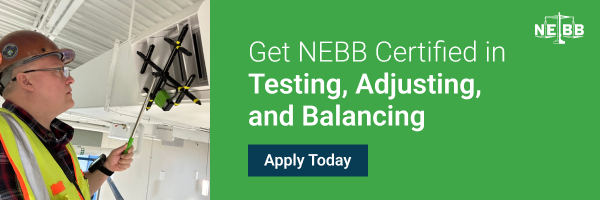
For the last 10 years, there has been a steady march towards energy efficiency reflected in New York City (NYC) building mechanical codes, which is my firm’s primary area of service. Presently, throughout the United States and not just major metropolitan jurisdictions, most HVAC industry stakeholders are striving to reduce energy consumption while maintaining performance and occupant comfort in every opportunity available.
Some of those energy efficiency opportunities are innovations in technology such as ECM drives, variable refrigerant systems eliminating the need for multiple condensing units and large duct runs, and pressure-independent control valves reducing hydronic overflow conditions throughout the building.
When innovating is not the answer to increasing efficiency, reducing wasted energy is the next target. NEBB certified TAB firms may be familiar with their portion in this reduction of wasted energy by taking part in Air Duct Leakage Testing scopes for their projects, either witnessing or executing the test. Typically, the project will test a duct riser or medium pressure duct from the inlet of a terminal device such as a VAV to the inlet of the air handler. Eliminating leakage at the air handling unit by specifying AHU Case Leakage Testing is one step in that effort.
Since air handlers are manufactured, TAB firms have traditionally had very little to do with Case Leakage Tests. The factory establishes a performance sheet based on AHRI criteria in a testing lab. NEBB Procedural Standards only prescribe performance testing of the units, never developing testing methods for AHU Case Leakage.
The manufacturer tests the units following AHRI Standards 1350 (I-P) and 1351(SI) Mechanical Performance Rating of Central Station Air-handling Unit Casings and/or AMCA Standard 210-2007 for their testing methodology, and resulting data is used to rate the performance listed in the manufacturer equipment submittal.
However, for larger air handling equipment that logistically can only be built up onsite by the contractor who deals with many large sections (sometimes stacked one on top of another), a factory test can no longer ensure case integrity in the field. Mechanical engineers have recognized the need to confirm the integrity of these cases because of their concern about leakage at the section connections, seals, doors, panels, electrical penetrations, flanges, and other openings that have been affected by field construction activities.
I think most TAB professionals can testify to witnessing what happens when a unit is porous with a high suction or discharge static. On occasion, my firm has witnessed enough case leakage that by doing the integrity test and resealing, a regain of up to 5 percent total design CFM airflow is possible. This is impactful with units that move CFM by the tens of thousands.
In this article, information is provided detailing where case leakage testing shows up in the job specification, how to prepare case leakage testing procedures, and some best practices for executing your method of procedure. Understand that the standards for case leakage testing are guideposts, and the manufacturer may provide a manual for field case leakage testing that would be relied upon to run the test.
Case deflection is often specified as part of the Case Leakage Test. This is a test that measures the deflection of a pressurized cabinet section at a fixed point midway on the exterior panel. Deflection measurements are taken during the positive pressurization test. Deflection measurements will not be discussed further in this article.
It is important to define the AHU case or cabinet. The case or cabinet is the enclosure which houses the fans, coils, filters, and other components of the AHU and is generally made of metal and lined, as necessary, with material for thermal insulation and/or acoustic attenuation. It contains the air that is being conditioned, is exposed to the fan pressure, and separates the conditioned air from the surrounding air. This does not include the inlet or outlet connected to ductwork or accessories such as an outside air economizer hood connection for a typical multi-section field erected rooftop unit.
In 2022 my firm, Airpath Testing Services, was solicited to perform Field Case Leakage Testing on more than 50 built-up air handling units at 270 Park Ave, the new JP Morgan Chase Headquarters. Each floor was designed with two or more built-up air handling units. The initial request for this scope came from the “Rider A” pages of the bid solicitation for the prime mechanical contractor. Airpath was only engaged after we had contracted TAB services. That is often the case since this request does not originate in the TAB specification. Refer to the following excerpt for the language that would initiate a unit case leakage testing scope:
“AHU PRESSURIZATION SCOPE: RIDER A SECTIONS 6-C: Perform the re-assembly and sealing of the units once delivered to the site. Once re-assembly is complete and signed off by the vendor, the Contractor shall perform the air leakage testing of the unit onsite, including development of testing plan with the equipment manufacturer. At a minimum, the following shall be performed by the Ventilation Contractor and overseen by the Vendor for final signoff.
i. Air Pressurization test once field assembly is complete. Maximum allowable air leakage shall be 1.0 percent of design airflow at 1.5 times scheduled total static pressure for the air-handling unit as installed.
ii. Air-leak testing shall be performed by measuring the airflow pumped into (or out of) the unit at the cabinet design operating static pressure. All supply and return air openings shall be sealed along with the air seal at the supply fan to isolate the high and low side of the unit. The air shall then be pumped into (or out of) the unit until the specified leakage rating pressures are achieved. Airflow measurements shall be performed in compliance with AMCA Standard 210-2007. The testing shall be witnessed by the Owner’s Representative. A detailed report, including all data and test methods, shall be submitted.
The next step to satisfying this scope is to develop a method of procedure for approval by the project Mechanical Engineering Consultant. Sample Method of Procedure:
AHU Preparation Example using Oriflow Test Rig:
- Prepare the allowable leakage calculation based on the supply fan total static pressure (TSP) rating times 1.5 or 10 in wg” (the engineer or manufacturer will specify the pressure limit).
- The allowable leakage calculation is the same for the positive and negative test of the AHU case.
- Install the blank-off plate at the openings indicated in the schematic. Use rope caulk to form a removable airtight gasket sandwiched between each blank-off plate and the AHU case surface. Cut a 6-inch diameter opening in the blank-off plate to affix a 6” round sheet metal collar used to pressurize the AHU interior chambers. Drill a 3/8” diameter hole into the blank-off plate and insert a small ¼’’ rubber hose through the hole and into the air handler case. Attach the opposite hose end to a calibrated manometer to measure interior chamber static pressure during the pressure test.
- Set up the Oriflow pressure testing / flow blower rig. Attached is the test hose between the rig and the affixed 6” pressure test collar. Select the appropriate orifice plate for the test and install it into the test rig extension tube flange.
- The test rig has two “on-board” digital manometers (pressure gauges). Use one gauge to measure the orifice plate differential pressure. The second digital pressure gauge is used to measure the internal static pressure of the AHU test section.
- For AHUs with 60 percent or more section length being negative, a single test can take place for the depressurization leakage rate. (Please note that a deflection test in a positive pressurization test will likely still be required.) Where less than 60 percent length is measured on the negative side of the fan, perform two tests: one test series on the discharge side and one series on the suction side. Plastic should be rolled out or sheet metal blankets with gaskets applied to separate the sections. Typically, the contractor will cover the inlet of the fan with screw-in sheet metal blanks with gasket.
AHU Case Leak and Pressure Testing:
- With the AHU test chamber prepared for blower pressure testing, slowly introduce air into the chamber using the rig blower fan speed controller on the test rig. Advance the fan speed until the desired test pressure is achieved. Holding the fan speed steady, measure and record the orifice differential pressure. The airflow leakage is either calculated using the orifice plate flow equation (CFM= orifice CFM @ 1’’ plate differential pressure) or from the orifice plate flow chart) see the Oriflow pressure chart in appendix.
- If the fan speed setting on the pressure and flow test rig is set to maximum speed, but the required case test pressure is not achieved, attach a booster fan to the test rig fan inlet to increase test pressure and flow. The internal static pressure within the AHU case will improve and most likely achieve the required test pressure.
- Since the fan test rig includes an in-line orifice plate flow meter to measure air leakage, the orifice differential pressure flow calculation, or the flow vs. differential pressure chart (CFM leakage vs. orifice differential pressure.) will be used to determine airflow through the orifice. This is the same airflow leaking through the air handler case. The leakage corresponds to the differential pressure meter measurement as it relates to the chart CFM listed at that differential pressure.
- If the test flow rate is less than the maximum allowable leakage, the test passes. If the actual flow is greater than the allowable case leakage, the test fails. The team should look for sources of excess air leakage. A fog machine or smoke bomb can be used to visualize escaping smoke from holes and seams. Repair / seal those leak locations to reduce leakage and retest until the leakage rate is below the allowable limit at the assigned test pressure.
There are typically 2 tables provided to establish the case leakage test pressure and the allowable leakage: the Case Testing Criteria and the Test Results Summary Table. The Case Testing Criteria table for the 270 Park project required a test pressure at 1.5 times the total static pressure of the unit. So, in the instance of the AHU, that would be a TSP of 4” wc with a test pressure of 6” wc.
The allowable leakage was prescribed at 1 percent of the design CFM. The calculation for this allowance is 20,000 CFM multiplied by 1 percent, equating to 200 CFM. The unit is tested at 6” wc on the inlet section and outlet section of the AHU.
While Case Leakage Testing is already becoming more popular in the New York HVAC sector, it is likely that this type of leakage method will be specified in more projects throughout the United States. Built-up air handling units are increasingly adding integration of supply and return or exhaust energy recovery components. This added assembly in the AHU cabinet is inviting more opportunity for leakage resulting from assembly activities and other trades penetrating the casing for control, electrical, and drainage. AHU Case Leakage Testing is an opportunity for the NEBB professional to apply their knowledge and existing equipment toward successful execution of this test scenario.
Looking forward, the NEBB certified professional should recognize that leveraging their experience can lead to many more opportunities in a continually evolving field.
